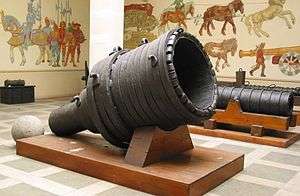Pumhart von Steyr
The Pumhart von Steyr is a medieval large-calibre cannon from Styria, Austria, and the largest known wrought-iron bombard by caliber.[1] It weighs around 8 tons and has a length of more than 2.5 meters. It was produced in the early 15th century and could fire, according to modern calculations, an 80 cm stone ball weighing 690 kg to a distance of roughly 600 m after being loaded with 15 kg of gunpowder and set at an elevation of 10°.[2]
| Pumhart von Steyr | |
|---|---|
 The Pumhart von Steyr in the Heeresgeschichtliches Museum at Vienna | |
| Type | Cannon |
| Place of origin | Liezen, Styria, Holy Roman Empire |
| Service history | |
| Used by | Habsburg |
| Production history | |
| Designed | Early 15th century |
| Specifications | |
| Mass | ~ 8 t |
| Length | 259 cm |
| Barrel length | 144 cm |
| Diameter | 76–88 cm (conical muzzle) |
| Shell weight | 690 kg |
| Caliber | 80 cm (ball diameter) |
| Maximum firing range | ca. 600 m |
The bombard is today on display in one of the artillery halls of the Heeresgeschichtliches Museum at Vienna.
Besides the Pumhart von Steyr, a number of 15th-century European large-calibre weapons are known to have been employed primarily in siege warfare, including the wrought-iron Mons Meg and Dulle Griet as well as the cast-bronze Faule Mette, Faule Grete and Grose Bochse.
Footnotes
- Schmidtchen 1977, p. 162
- Schmidtchen 1977, p. 163
References
- Schmidtchen, Volker (1977), "Riesengeschütze des 15. Jahrhunderts. Technische Höchstleistungen ihrer Zeit", Technikgeschichte, 44 (2): 153–173 (162–164)
- Schmidtchen, Volker (1977). Bombarden, Befestigungen, Büchsenmeister: Von den ersten Mauerbrechern des Spätmittelalters zur Belagerungsartillerie der Renaissance. Düsseldorf: Droste. pp. 33–34. ISBN 3-7700-0471-X.